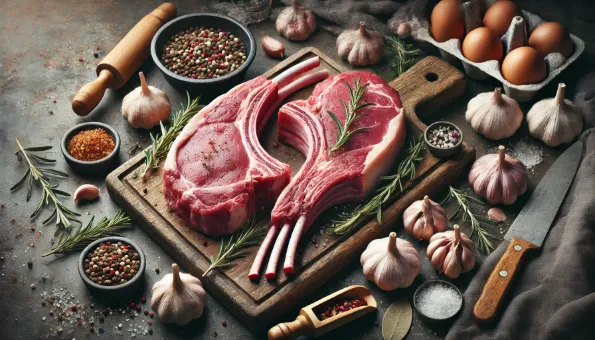Lamb: Tender, Flavorful Red Meat Supplying High-Quality Protein, Heme Iron, B12, Zinc & Conjugated Linoleic Acid
Young sheep meat (typically <12 months) with distinct grassy, slightly sweet flavor; rich in complete protein, heme iron, B12, niacin, zinc, selenium and healthy fats when trimmed.

What Is Lamb?
Lamb is meat from **young sheep usually under 12 months** (older becomes mutton with stronger flavor). Carcass is divided into primal cuts: leg, loin, rack, shoulder, breast, shank. Flavor nuances derive from **pasture diet (branched-chain fatty acids)** and age. Grass-fed systems often yield more pronounced ‘pastoral’ aroma compared with grain-finished.
Nutrition (per 100 g cooked lean, roasted leg/loin, trimmed)
| | Amount | Notes |
|---|---|---|
| Calories | 205–215 kcal | Higher if more visible fat left |
| **Protein** | 27–29 g | Complete AA profile |
| **Fat** | 9–10 g | ~40–45% SFA, 40–45% MUFA, small PUFA |
| – CLA (cis-9, trans-11) | 0.3–0.6 g | Varies pasture vs grain |
| **Iron (heme)** | 1.7–2.1 mg | ~10–12% DV |
| **Zinc** | 4–5 mg | 35–45% DV |
| **Selenium** | 25–30 µg | 45–55% DV |
| **Vitamin B12** | 2.0–2.5 µg | 80–100% DV |
| Niacin (B3) | 6–8 mg | 40–50% DV |
Sodium naturally low unless processed/marinated.
Potential Benefits
- **High-quality protein** supports muscle maintenance & satiety.
- **Heme iron & B12** aid oxygen transport, red blood cell production & neurological function.
- **Zinc & selenium** support immune enzymes and antioxidant defenses (glutathione peroxidase).
- **CLA & taurine**: lamb provides modest amounts under study for metabolic, antioxidant roles (context: overall dietary pattern matters more).
- **Pasture-raised lamb** may have slightly higher omega-3 (ALA, long-chain) & antioxidant vitamin precursors (β-carotene) versus grain-finished.
Drawbacks & Precautions
- **Saturated fat**: fattier cuts (rib/rack, shoulder) raise total SFA; trim external fat & moderate portion sizes to support heart health goals.
- **Caloric density**: energy-dense when cooked with rendered fat—balance plates with vegetables & whole grains.
- **Purines**: like other red meats, contribute to uric acid; moderate intake if managing gout (rotate lean poultry, plant proteins).
- **High-heat charring** can form HCAs/PAHs; use gentle roasting, avoid excessive blackening.
- **Allergy** rare but possible (alpha-gal syndrome in some tick regions may involve mammalian meat).
Culinary Uses
- **Quick-cook tender cuts:** Loin chops, rib/rack, leg steaks → high-heat sear + medium-rare finish (~57–60 °C internal) for juiciness.
- **Roasts:** Whole leg (bone-in or boneless), shoulder (slow-roasted or braised), rack (Frenched) with herb crust.
- **Ground lamb:** Burgers, kofta, kebabs, moussaka, shepherd’s pie (balance with aromatics & legumes for lighter profile).
- **Slow braises:** Shanks & shoulder become succulent with collagen conversion (low, moist heat 2–3+ h).
- **Global flavor frames:** Rosemary–garlic, mint, Middle Eastern (cumin, coriander, sumac), North African (ras el hanout), Indian (garam masala), Mediterranean (oregano, lemon).
Technique & Optimization
- **Trim external fat caps** to reduce flare-ups & excess saturated fat; retain thin layer for moisture.
- **Dry brine (salt 0.8–1% weight)** 6–24 h ahead to enhance juiciness & seasoning.
- **Temperature control:** Pull roasts ~3–5 °C below target; rest tented (carryover finish).
- **Marinades with acid/herbs** (yogurt, citrus, wine) can tenderize surfaces & moderate ‘gamey’ notes; yogurt’s lactic acid + enzymes effective.
- **Lower charring:** Sear then finish indirectly; or sous-vide then brief high-heat color (reduces HCA formation).
Health & Portion Guidance
- **Portion**: 85–100 g cooked lean lamb (about a palm) fits most balanced diets 2–3× per week or less, alongside seafood, legumes & poultry for variety.
- Pair with **fiber-rich sides** (lentils, chickpeas, leafy greens, whole grains) to offset higher fat & enhance micronutrient synergy (vitamin C from vegetables improves non-heme iron absorption in mixed meals).
- Rotate leaner cuts (leg, loin) more often than fattier rack/shoulder for lipid management.
Sustainability & Ethical Considerations
Lamb production impact varies by system. **Pasture-based & rotational grazing** can support soil health, carbon sequestration in grasslands & biodiversity if stocking rates appropriate. Enteric methane remains a factor; choosing producers investing in **improved forage management, feed efficiency & welfare practices** (low-stress handling, outdoor access) improves footprint. Utilize whole cuts—render trimmed fat for cooking, make stock from bones—to **reduce waste**.
Storage & Food Safety
Raw lamb: refrigerate ≤4 °C—use ground within 1–2 days; whole cuts 3–5 days. Freeze (airtight) 6–9 months best quality. Cook to **63 °C (145 °F) + 3 min rest** for whole cuts (food safety authorities), 71 °C (160 °F) for ground. Leftovers: refrigerate promptly (<2 h) and consume within 3–4 days.
Key Takeaways
✔︎ Dense source of high-quality protein, heme iron, B12, zinc & selenium
✔︎ Flavorful; moderate portions satisfy
✖︎ Higher saturated fat & environmental footprint vs many plant proteins—trim, portion & diversify protein sources.
- 1. Lamb
Used in dashi and other broths

